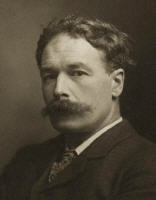
Henry Scott Tuke is one of the most well known of the Newlyn school, the famous group of artists who worked in and around this Cornish fishing village from about 1880-1920. Tuke specialised in fishing and beach scenes. He enrolled at the Slade School in London in 1875, and among his fellow students was William Strang. Later he travelled to Italy, living for a time in Florence. He was influenced by the English artist Arthur Lemon, with whom Tuke made a painting expedition to the Tuscan coast at Livorno in the course of which he first experimented with his most characteristic subject, bathing children and young men. Between 1881 and 1883 Tuke lived in Paris, where he made contact with Jules Bastien Lepage - of all French artists the most influential for the rising generation of British impressionists - and at the same time he worked at the Academie Julian under the history painter Jean-Paul Laurens. On his return to England in 1883, Tuke visited Newlyn, where a community of landscape artists was being established. In 1885 he settled in Falmouth, another picturesque port of the south coast of Cornwall (where in fact the Tuke family had spent holidays during the artist's boyhood). From 1886 Tuke owned a French brigantine, Julie of Nantes, on which he built a studio. For a time Tuke's style of painting remained typical of the group of French-influenced artists who settled in Cornwall in the 1880s - for example in his use of the square-brush technique and his fondness for muted and atmospheric colour. Works of this kind formed the staple of his exhibits at the New English Art Club, of which he was a founding member in 1887. Gradually, however, he moved toward a brighter palette and more elaborate compositions. A visit to Venice led to a further brightening of his range of colours. Tuke's search for models who were prepared to allow him to paint them in the nude seems to have caused consternation among the fishing communities. His friend and fellow painter Stanhope Forbes, reported: 'Tuke is staying near Falmouth and likes the place very much but can get no models and has been forced to have a boy from London whom he boards and lodges. So he is painting this British youth in the style the British matron so strongly objects to.' If in the early stages of his career Tuke's style of art and subject matter was found alarming, by the mid-1890s his paintings of bathing boys were looked for in the summer exhibitions and were much admired. In 1894 his painting August Blue was bought for the nation by the Chantrey Bequest.